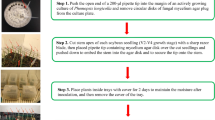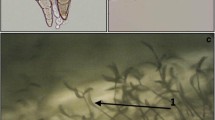Abstract
Downy mildew, caused by the obligate oomycete Peronospora effusa (Pfs), is the most economically important disease of spinach. In recent years, numerous new races of the pathogen have overcome the resistance used in newly released cultivars. Resistance to Pfs in spinach is predominantly governed by dominant major resistance genes (RPFs) that are widely used in commercial spinach hybrid cultivars. Currently, a labor and resource-intensive inoculation test of whole plants, in a large tray format, in a temperature-controlled growth chamber and dew chamber, is employed to evaluate the resistance of spinach germplasm and to characterize races of the downy mildew pathogen. The objective of this work was to evaluate, standardize, and validate a more efficient detached leaf inoculation method to differentiate resistant and susceptible spinach genotypes and characterize Pfs races on a standardized set of spinach differential genotypes. Detached leaves and cotyledons of standard host differentials commonly used for race differentiation were placed on water agar in closed Petri dishes and inoculated by spraying the leaves with a spore suspension of Pfs inoculum. Disease incidence and severity on detached leaves and cotyledons were compared to the response of the corresponding cultivars in the standard whole-plant assay. There was a complete match between the disease reaction on whole plants and the disease reaction on detached leaves for all three races of Pfs examined. Furthermore, the obligate pathogen could infect, sporulate, and maintain pathogenicity by propagation solely on detached leaves. The detached leaf assay could facilitate advances in breeding for Pfs by evaluating resistance, pathogen race identification, and studies on epidemiology and genetics of the pathogen as the tests are less labor, resource-intensive than the whole-plant assay format, and environmental variables can be more accurately controlled.


Similar content being viewed by others
References
Boso, S., & Kassemeyer, H. H. (2008). Different susceptibility of European grapevine cultivars for downy mildew. Vitis - Journal of Grapevine Research., 49, 1452–1462. https://doi.org/10.1016/j.cortex.2012.07.003.
Brandenberger, L. P., Correll, J. C., & Morelock, T. E. (1991). Identification of and cultivar reactions to a new race (race 4) of Peronospora farinosa f. sp. spinaciae on spinach in the United States. Plant Disease, 75, 630–634.
Brooks, F. E. (2008). Detached-leaf bioassay for evaluating taro resistance to Phytophthora colocasiae. Plant Disease, 92, 126–131. https://doi.org/10.1094/PDIS-92-1-0126.
Correll, J. C., Bluhm, B. H., Feng, C., Lamour, K., du Toit, L. J., & Koike, S. T. (2011). Spinach: Better management of downy mildew and white rust through genomics. European Journal of Plant Pathology, 129(2), 193–205. https://doi.org/10.1007/s10658-010-9713-y.
Dhillon, B., Feng, C., Villarroel-Zeballos, M. I., Castroagudin, V. L., Bhattarai, G., Klosterman, S. J., & Correll, J. (2020). Sporangiospore viability and oospore production in the spinach downy mildew pathogen, Peronospora effusa. Plant Disease. https://doi.org/10.1094/pdis-02-20-0334-re.
Dijkstra, J., Correll, J. C., Smilde, D., & Visser, J. de. (2011). The role of the International Working Group on Peronospora (IWGP). In International Spinach Conference 2011. https://spinach.uark.edu/amsterdam-october-2011/
Feng, C., Correll, J. C., Kammeijer, K. E., & Koike, S. T. (2014). Identification of new races and deviating strains of the spinach downy mildew pathogen Peronospora farinosa f. sp. spinaciae. Plant Disease, 98(1), 145–152. https://doi.org/10.1094/PDIS-04-13-0435-RE.
Feng, C., Saito, K., Liu, B., Manley, A., Kammeijer, K., Mauzey, S. J., Koike, S., & Correll, J. C. (2018). New races and novel strains of the spinach downy mildew pathogen Peronospora effusa. Plant Disease, 102(3), 613–618. https://doi.org/10.1094/PDIS-05-17-0781-RE.
Goth, R. W., & Keane, J. (1997). A detached-leaf method to evaluate late blight resistance in potato and tomato. American Potato Journal, 74, 347–352. https://doi.org/10.1007/BF02851579.
Irish, B. M., Correll, J. C., Koike, S. T., & Morelock, T. E. (2007). Three new races of the spinach downy mildew pathogen identified by a modified set of spinach differentials. Plant Disease, 91(11), 1392–1396.
Irish, B. M., Correll, J. C., Koike, S. T., Schafer, J., & Morelock, T. E. (2003). Identification and cultivar reaction to three new races of the spinach downy mildew pathogen from the United States and Europe. Plant Disease, 87(5), 567–572. https://doi.org/10.1094/PDIS.2003.87.5.567.
Kandel, S. L., Mou, B., Shishkoff, N., Shi, A., Subbarao, K. V., & Klosterman, S. J. (2019). Spinach downy mildew: Advances in our understanding of the disease cycle and prospects for disease management. Plant Disease, 103, 791–803. https://doi.org/10.1094/PDIS-10-18-1720-FE.
Klosterman, S. J. (2016). Spinach downy mildew: Threat, prevention & control. Progressive Crop Consultant, 1, 13–15.
Kubota, M., Tamura, O., Nomura, Y., Orihara, N., Yamauchi, N., Yonemoto, K., et al. (2017). Recent races of spinach downy mildew pathogen Peronospora farinosa f. sp. spinaciae in Japan. Journal of General Plant Pathology. https://doi.org/10.1007/s10327-017-0698-7.
Liu, G., Kennedy, R., Greenshields, D. L., Peng, G., Forseille, L., Selvaraj, G., & Wei, Y. (2007). Detached and attached Arabidopsis leaf assays reveal distinctive defense responses against Hemibiotrophic Colletotrichum spp. Molecular Plant-Microbe Interactions, 20, 1308–1319. https://doi.org/10.1094/MPMI-20-10-1308.
Lyon, R., Correll, J., Feng, C., Bluhm, B., Shrestha, S., Shi, A., & Lamour, K. (2016). Population structure of Peronospora effusa in the southwestern United States. PLoS One, 11, e0148385. https://doi.org/10.1371/journal.pone.0148385.
Morelock, T. E., & Correll, J. C. (2008). Spinach. In Vegetables I (pp. 189–218). Springer, New York, NY. https://doi.org/10.1007/978-0-387-30443-4_6.
Nyassé, S., Cilas, C., Herail, C., & Blaha, G. (1995). Leaf inoculation as an early screening test for cocoa (Theobroma cacao L.) resistance to Phytophthora black pod disease. Crop Protection. https://doi.org/10.1016/0261-2194(95)00054-2.
Satou, M., Nishi, K., Kubota, M., Fukami, M., Tsuji, H., & van Ettekoven, K. (2006). Appearance of race Pfs:5 of spinach downy mildew fungus, Peronospora farinosa f. sp. spinaciae, in Japan. Journal of General Plant Pathology, 72(3), 193–194. https://doi.org/10.1007/s10327-005-0266-4.
Testen, A. L., Jiménez-Gasco, M. D. M., Ochoa, J. B., & Backman, P. A. (2014). Molecular detection of Peronospora variabilis in quinoa seed and phylogeny of the quinoa downy mildew pathogen in South America and the United States. Phytopathology, 104, 379–386. https://doi.org/10.1094/PHYTO-07-13-0198-R.
USDA-NASS (2019). Agricultural statistics 2019. https://www.nass.usda.gov/.
Vleeshouwers, V. G. A. A., Van Dooijeweert, W., Keizer, L. C. P., Sijpkes, L., Govers, F., & Colon, L. T. (1999). A laboratory assay for Phytophthora infestans resistance in various Solanum species reflects the field situation. European Journal of Plant Pathology, 105(3), 241–250. https://doi.org/10.1023/A:1008710700363.
Yamauchi, N., Horinouchi, H., Sakai, K., Yonemoto, K., Satou, M., & Shirakawa, T. (2011). First report of spinach downy mildew caused by race Pfs:8 of Peronospora farinosa f. sp. spinaciae in Japan. Journal of General Plant Pathology. https://doi.org/10.1007/s10327-011-0313-2.
Author information
Authors and Affiliations
Corresponding author
Ethics declarations
All principles of ethical and professional conduct have been followed during the research and elaboration of this manuscript.
Ethical statement
All authors consent to the submission of this manuscript. The manuscript has been prepared following principles of ethical and professional conduct. The research did not involve human participants and did not involve animal subjects; therefore, neither submission of human consent nor statement on the welfare of animals is applicable.
Conflict of interest
The authors declare that they have no conflict of interest.
Informed consent
All authors have reviewed the manuscript and approved its submission to the European Journal of Plant Pathology.
Rights and permissions
About this article
Cite this article
Bhattarai, G., Feng, C., Dhillon, B. et al. Detached leaf inoculation assay for evaluating resistance to the spinach downy mildew pathogen. Eur J Plant Pathol 158, 511–520 (2020). https://doi.org/10.1007/s10658-020-02096-5
Accepted:
Published:
Issue Date:
DOI: https://doi.org/10.1007/s10658-020-02096-5




